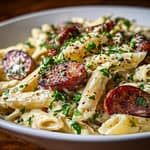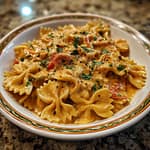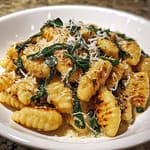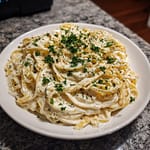Bright, zesty, and bursting with seasonal freshness, this dish combines tender pasta, crisp spring vegetables, and a hint of lemon for an easy yet impressive dinner.
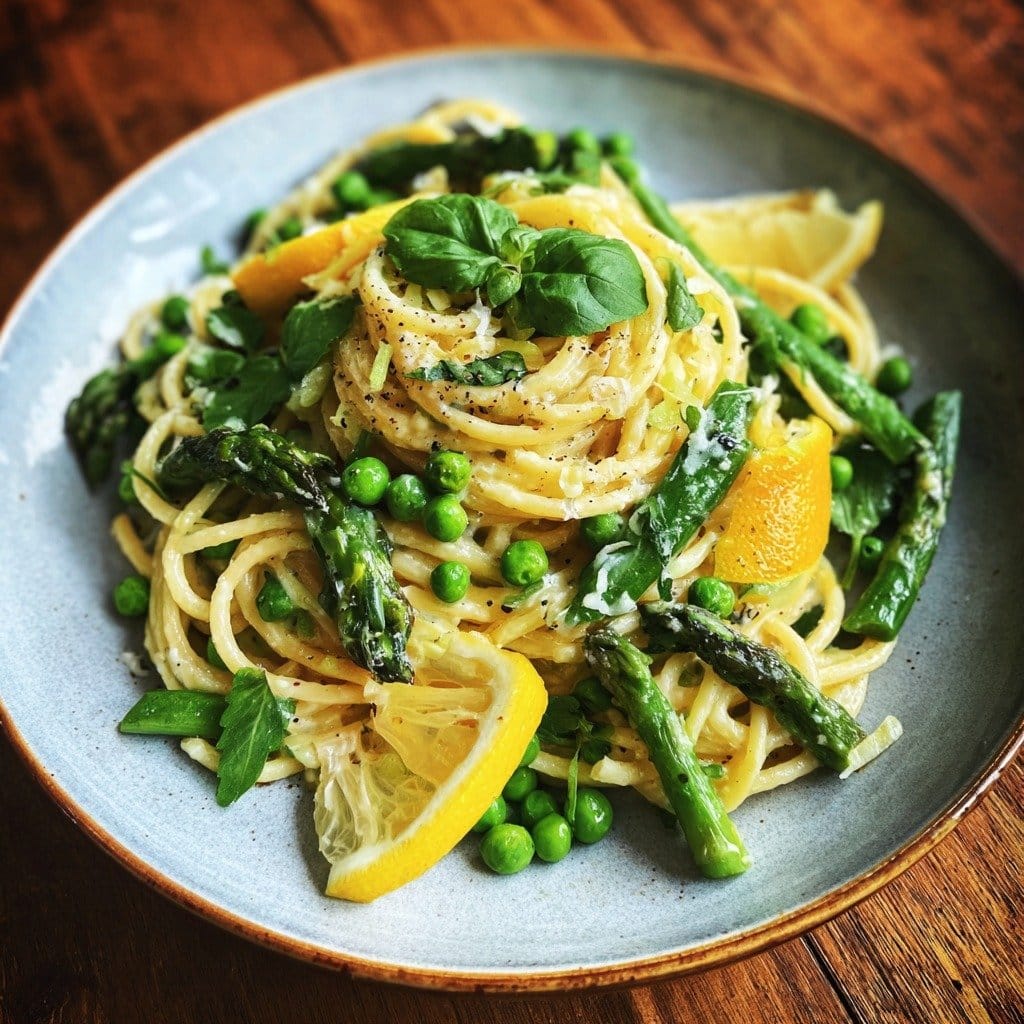
Introduction
Imagine a plate of twirling pasta coated in a silky lemon-herb sauce, mingled with tender asparagus, sweet peas, and fresh basil. It’s simple, light, and exactly the kind of comfort-for-dinner that doesn’t weigh you down.
Table of Contents
Origin / Background
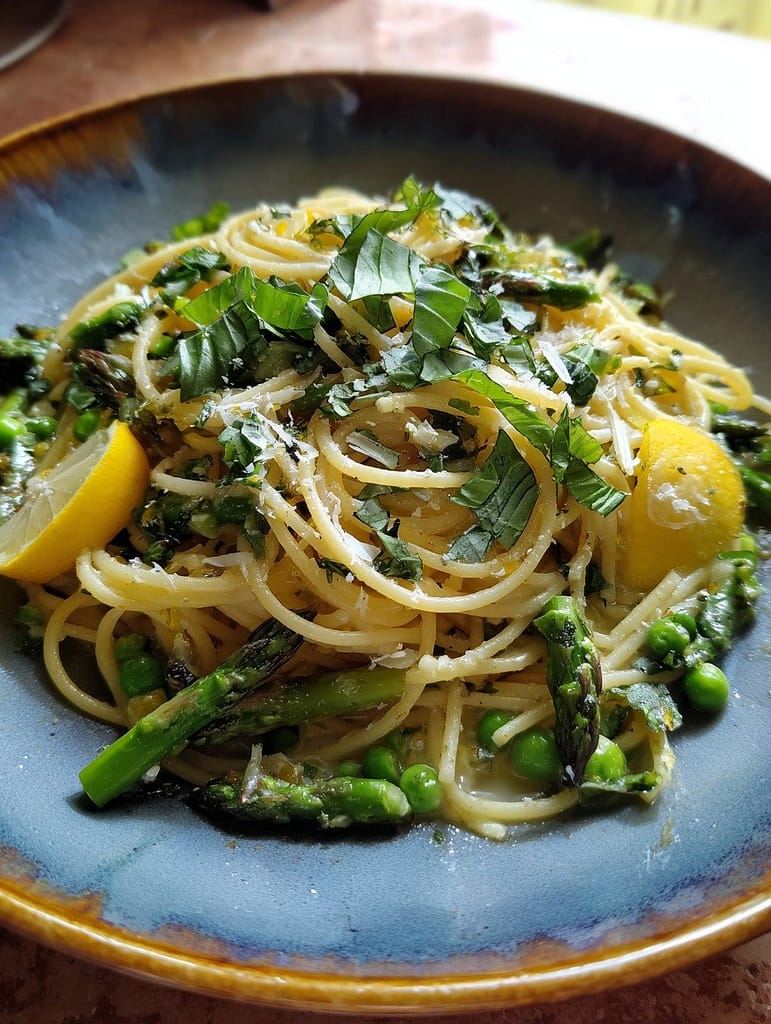
Lemon and herb pasta recipes have deep roots in Mediterranean cooking, celebrating the union of garden-fresh herbs with citrus for balanced, fragrant meals.
Ingredients
- 300g spaghetti or linguine
- 200g asparagus, trimmed & cut into 2-inch pieces
- 1 cup fresh or frozen peas
- 2 tbsp olive oil
- 1 tbsp butter
- 2 cloves garlic, minced
- 1 medium lemon (zest & juice)
- 1/2 cup grated Parmesan cheese
- Small handful fresh basil leaves
- Small handful parsley, chopped
- Salt & pepper to taste
Step-by-Step Preparation Instructions
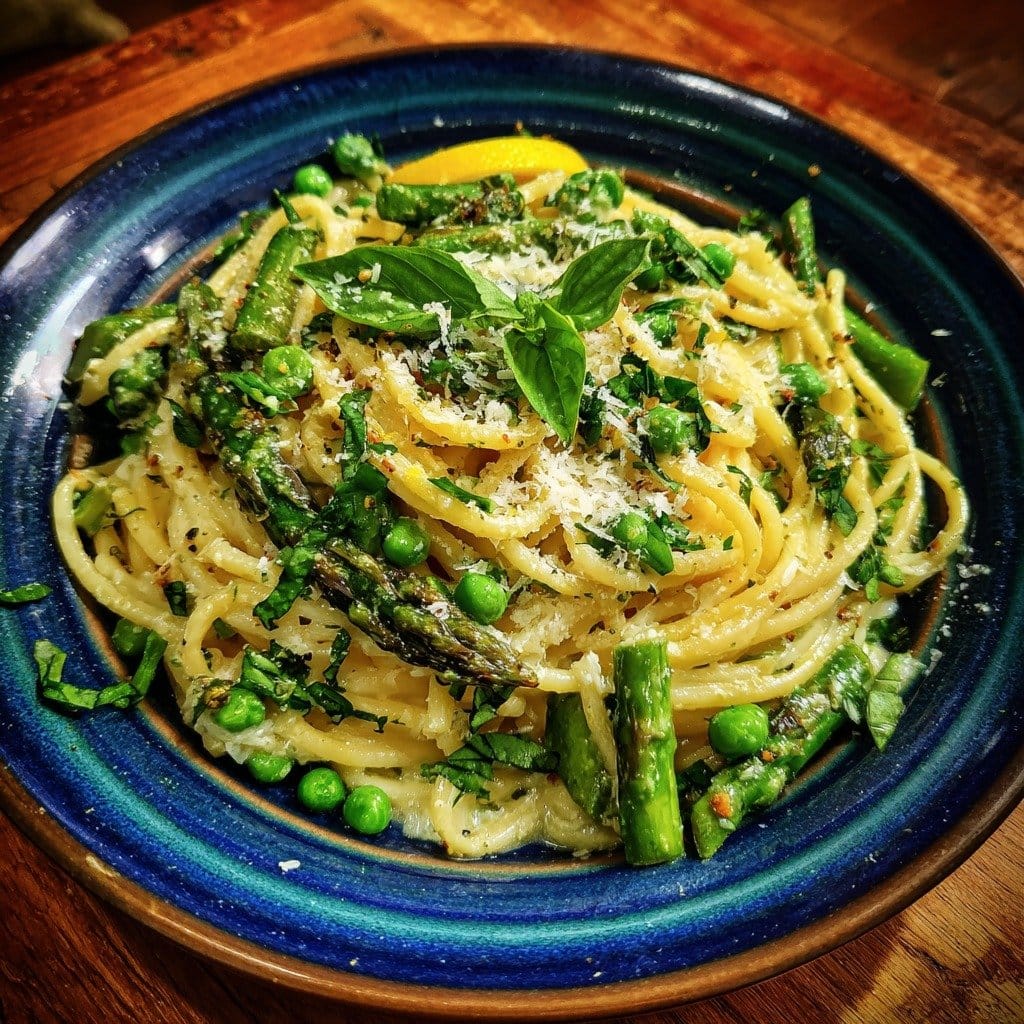
1. Cook the Pasta
- Bring a large pot of salted water to a boil.
- Add pasta and cook according to package directions until just al dente.
- Before draining, reserve 1 cup of the pasta water. This will help emulsify the sauce later.
Beginner Tip: Always salt the pasta water generously—it should taste like the sea. This is your first layer of flavor.
2. Blanch the Vegetables
- In the last 3 minutes of pasta cooking, drop the asparagus pieces into the boiling water.
- Add peas in the last 1 minute.
- Drain everything together, setting aside that reserved pasta water.
3. Prepare the Lemon-Herb Base
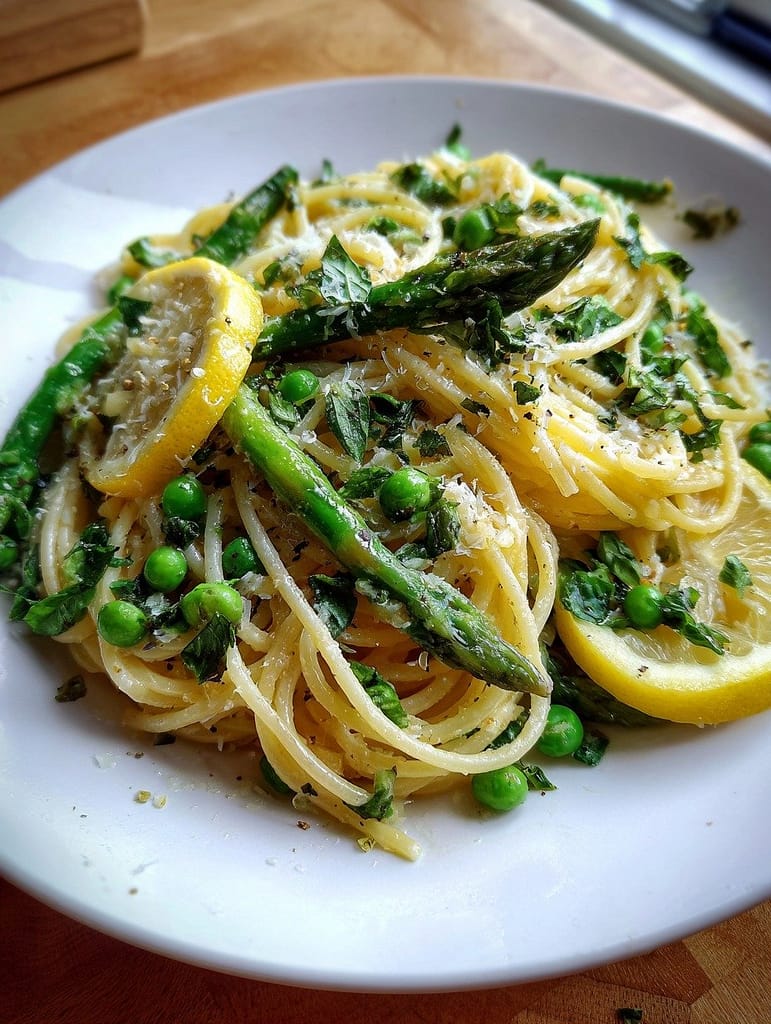
- In a large skillet over medium heat, warm the olive oil and butter together.
- Add minced garlic and sauté gently for 30 seconds until fragrant—avoid browning.
- Stir in lemon zest for a few seconds to release oils.
Beginner Tip: Lemon zest carries the flavor; juice adds brightness. Using both creates a balanced taste.
4. Combine Pasta & Vegetables with Sauce
- Add the cooked pasta and vegetables to the skillet.
- Pour in the lemon juice and half of the reserved pasta water.
- Toss to combine, adding a little more water if the mixture seems dry. The sauce should coat the pasta in a glossy layer.
5. Finish with Cheese & Herbs
- Remove skillet from heat.
- Sprinkle in Parmesan cheese, tossing until slightly creamy.
- Add the fresh basil and parsley.
- Season with salt and pepper to taste.
Beginner Tip: Always taste before serving—you can adjust lemon juice, herbs, or even add a pinch of chili flakes for heat.
Basics & Tips for Beginners
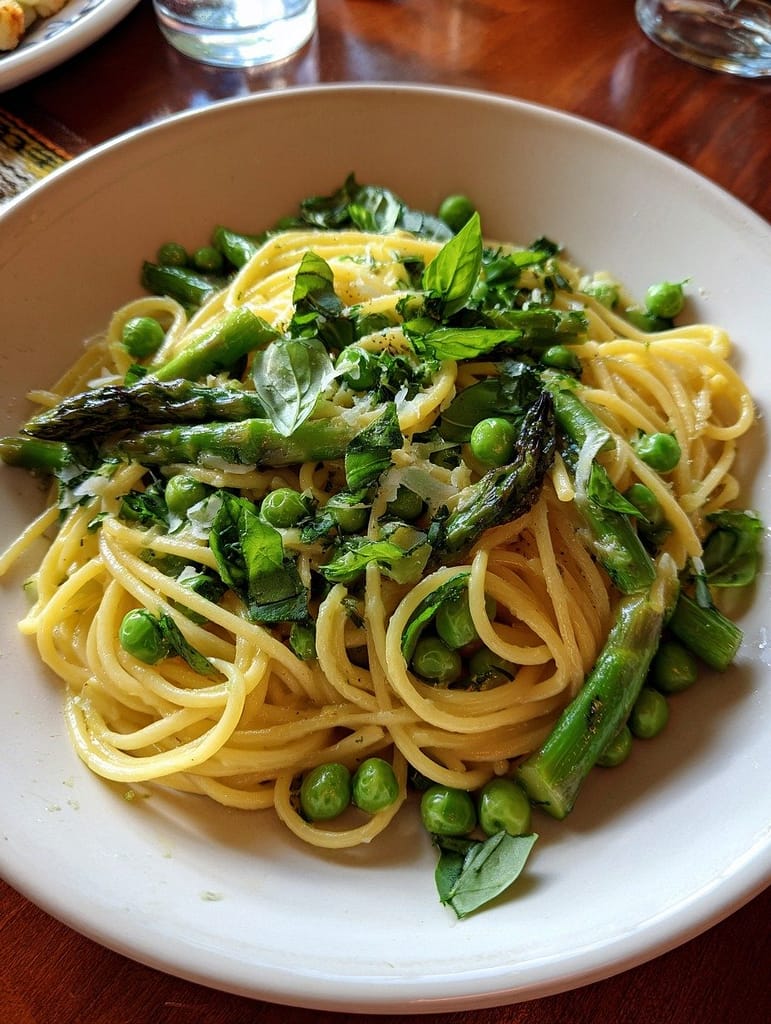
- Don’t overcook vegetables: They should be tender-crisp, still vibrant in color.
- Reserve pasta water: It’s starchy and helps bind the sauce together naturally.
- Mix off the heat: Cheese can clump if added over high heat.
- Prep ahead: Chop herbs and zest lemon before cooking starts.
Nutrition Facts / Summary (approximate per serving)
- Calories: 420 kcal
- Protein: 16g
- Carbs: 58g
- Fat: 14g
- Fiber: 6g

Fresh Herb Lemon Pasta with Spring Vegetables
- Total Time: 25 Minuten
- Yield: 4 Portionen
Description
Eine frische und helle Pastarezepte mit zarten Frühlingsgemüsen, aromatischen Kräutern und einer spritzigen Zitronensoße – perfekt für ein leichtes und befriedigendes Abendessen.
Ingredients
- 300g Spaghetti oder Linguine
- 200g Spargel, getrimmt und in 5 cm Stücke geschnitten
- 1 Tasse frische oder gefrorene Erbsen
- 2 EL Olivenöl
- 1 EL Butter
- 2 Knoblauchzehen, gehackt
- 1 mittelgroße Zitrone (Schale & Saft)
- ½ Tasse geriebener Parmesan
- Kleiner Bund frische Basilikumblätter
- Kleiner Bund Petersilie, gehackt
- Salz und Pfeffer nach Geschmack
Instructions
- Großen Topf mit Salzwasser zum Kochen bringen. Pasta nach Packungsanweisung al dente kochen. 1 Tasse Kochwasser zurückbehalten und abgießen.
- In den letzten 3 Minuten der Pasta-Kochzeit Spargel und Erbsen zum Blanchieren ins Wasser geben. Zusammen mit der Pasta abgießen.
- Olivenöl und Butter in einer großen Pfanne bei mittlerer Hitze erwärmen. Knoblauch 30 Sekunden anbraten bis duftet.
- Zitronenschale zugeben. Anschließend Pasta, Gemüse, Zitronensaft und die Hälfte des Pasta-Kochwassers dazugeben. Alles vermengen, bei Bedarf mehr Wasser zugeben.
- Von der Hitze nehmen, Parmesan, frische Kräuter, Salz und Pfeffer unterheben. Abschmecken und bei Bedarf nachwürzen.
- Sofort servieren, mit zusätzlichen Kräutern und Zitronenspiralen garnieren.
Notes
- Wasser zum Pasta kochen gut salzen für besseren Geschmack.
- Gemüse nicht verkochen, sie sollen knackig und farblich lebendig bleiben.
- Das zurückbehaltene Kochwasser hilft der Soße, sich schön zu binden.
- Spargel kann durch grüne Bohnen oder Brokkolini ersetzt werden.
- Für die vegane Variante Butter durch Olivenöl und Parmesan durch Hefeflocken ersetzen.
- Restliche Reste luftdicht im Kühlschrank bis zu 2 Tage aufbewahren und schonend erwärmen.
- Prep Time: 10 Minuten
- Cook Time: 15 Minuten
- Category: Hauptgericht
- Method: Kochen, Sautieren
- Cuisine: Mediterran
Nutrition
- Serving Size: 1 Portion
- Calories: 420
- Sugar: 4 g
- Sodium: 320 mg
- Fat: 14 g
- Saturated Fat: 5 g
- Unsaturated Fat: 8 g
- Trans Fat: 0 g
- Carbohydrates: 58 g
- Fiber: 6 g
- Protein: 16 g
- Cholesterol: 15 mg
Pro Tips & Substitutions
- Swap asparagus for green beans or broccolini if preferred.
- Use Pecorino Romano for a sharper cheese flavor.
- Add grilled chicken or shrimp for extra protein.
- Gluten-free pasta works well here.
Serving & Presentation Ideas
- Serve in shallow bowls for a rustic look.
- Garnish with extra basil leaves and a lemon twist.
- Pair with a crisp white wine or sparkling water with lemon.
Comparison with Similar Recipes
Compared to heavier cream-based pastas, this lemon-herb version is lighter, fresher, and more spring-focused. Unlike tomato-based pasta, this sauce builds flavor from aromatic oils, citrus, and herbs rather than acidity alone.
FAQ Section
Q1: Can I make this ahead of time?
Yes, but the pasta tastes best fresh. If making ahead, stop before adding cheese and herbs, then reheat gently and finish before serving.
Related Posts
-
Creamy Kielbasa Sausage Pasta SkilletLet me tell you about a pasta dish that packs comfort and is practically zero-skill:…
-
Chicken Cheez Recipe – The Crispy, Cheesy Chicken...If you love cheesy, crunchy, and downright addictive comfort food, you're in for a treat.This…
-
Roasted Red Pepper Parmesan Cream Sauce (Weeknight-Easy, Restaurant-Quality)Velvety, smoky-sweet, and beautifully sunset-colored, this roasted red pepper Parmesan cream sauce turns simple pasta,…
-
Mediterranean Zucchini Chicken Skillet – A One-PanIntroduction to Mediterranean Zucchini Chicken Skillet Mediterranean Zucchini Chicken When life is full of errands,…
-
Zucchini Lasagna Recipe – A Healthy and Delicious...Introduction If you love the comforting taste of traditional Italian lasagna but want something lighter,…
Q2: Can I use dried herbs?
Fresh herbs give the best flavor, but dried parsley or basil can work in a pinch—use about one-third of the fresh amount.
Q3: How do I store leftovers?
Store in an airtight container in the fridge for up to 2 days. Reheat gently with a splash of water.
Q4: Can I make it vegan?
Yes! Swap butter for extra olive oil and use nutritional yeast instead of cheese.
Related Posts
-
Creamy Kielbasa Sausage Pasta SkilletLet me tell you about a pasta dish that packs comfort and is practically zero-skill:…
-
Chicken Cheez Recipe – The Crispy, Cheesy Chicken...If you love cheesy, crunchy, and downright addictive comfort food, you're in for a treat.This…
-
Roasted Red Pepper Parmesan Cream Sauce (Weeknight-Easy, Restaurant-Quality)Velvety, smoky-sweet, and beautifully sunset-colored, this roasted red pepper Parmesan cream sauce turns simple pasta,…
-
Mediterranean Zucchini Chicken Skillet – A One-PanIntroduction to Mediterranean Zucchini Chicken Skillet Mediterranean Zucchini Chicken When life is full of errands,…
-
Zucchini Lasagna Recipe – A Healthy and Delicious...Introduction If you love the comforting taste of traditional Italian lasagna but want something lighter,…
Q5: What pasta shape works best?
Long shapes like spaghetti or linguine are great, but short ones like penne can hold bits of vegetables better.
Conclusion + Call to Action
With minimal fuss and seasonal charm, this Fresh Herb Lemon Pasta is an easy win for dinner. Try it tonight, snap a photo, and share your colorful creation—you might inspire someone else to bring a taste of spring to their table.
🍴 More Recipes
Related Posts
-
Creamy Kielbasa Sausage Pasta SkilletLet me tell you about a pasta dish that packs comfort and is practically zero-skill:…
-
Chicken Cheez Recipe – The Crispy, Cheesy Chicken...If you love cheesy, crunchy, and downright addictive comfort food, you're in for a treat.This…
-
Roasted Red Pepper Parmesan Cream Sauce (Weeknight-Easy, Restaurant-Quality)Velvety, smoky-sweet, and beautifully sunset-colored, this roasted red pepper Parmesan cream sauce turns simple pasta,…
-
Mediterranean Zucchini Chicken Skillet – A One-PanIntroduction to Mediterranean Zucchini Chicken Skillet Mediterranean Zucchini Chicken When life is full of errands,…
-
Zucchini Lasagna Recipe – A Healthy and Delicious...Introduction If you love the comforting taste of traditional Italian lasagna but want something lighter,…
